[one_half padding=”0 0 0 0px”]
Uberti Walker
[/one_half]
[one_half_last padding=”0 0 0 0px”]
[/one_half_last]
Editor’s note: The Walker is an odd gun. I’ve been wrestling with how to contextualize this review. The Walker is a modern reproduction of a piece of American History. It is a sidearm you could carry during black powder season. It is an exaggerated wild west gun that is as much fun to handle and hold as it is to shoot, maybe more. And it is a revolver capable of .357 like ballistics that you can buy without filling out a 4473. It’s all of these things, I think, which makes it so compelling. On with the review~
The Colt Walker revolver is a beast. It is a horse gun, meaning that it was designed to be carried on a saddle, not on your hip. It weighs about 4.5 pounds empty. The Walker was rumored to be the most powerful repeating handgun until the invention of the .357 Magnum. There were only 1,100 originals made way back in 1847. Shooting an originals is pretty much out of the question unless you pilfer one from a museum (we do not endorse this idea). Luckily for us, A. Uberti makes a very authentic reproduction. They sent us an example to test out and we are going to do our best to see if the claims of .357 type power are possible.
Background
Lets talk a little history before we get to the shooting. About a decade before the advent of the Walker, Sam Colt came up with his first revolver design. This first attempt was the Colt Paterson, named after the town it was made in. The Paterson was a delicate revolver. It was chambered in .32 and .36 calibers, had a fold down trigger and was generally pretty fragile. But it was a start. Colt kept searching for a government contract that would make his company prosper. The Army found that the Paterson design was not sturdy enough for military use. But the Texas Rangers liked them.
Everything is Bigger in Texas
One of the Texas Rangers that had a Colt Paterson was Samuel Walker. He was involved in the Battle of Bandera Pass where the 10 shots (two 5 shot Patersons per Ranger) helped the Rangers to victory even though they were greatly outnumbered. But it was still underpowered. Even then, back in eighteen-digity-six, folks were arguing about caliber.
Fast forward a couple of years and the War with Mexico is just starting. Sam Walker is now a member of the US Army and wants to equip his troops with bigger and more powerful revolvers. He wants a revolver that is capable of shooting a horse out from under a rider at 100 yards. The two Sams, Walker and Colt, exchange some letters and soon the Colt Walker was born. Not sure where they came up with the name.
The Specs
The Walker is a big ass handgun. It has a 9 inch barrel. The cylinders are deep enough to hold 60 grains of black powder. Its predecessor, the Paterson, only held around 25 and the 45 Long Colt originally held 40 grains of black powder as a maximum load. The Walker is a 44 caliber but uses over-sized round balls to seal the cylinder (we used .457 Hornady balls for the review). Did I mention it weighs 4.5 pounds empty? It weighs even more after you’ve carried it for a while. Not sure why.
The sights are very basic. There is a front blade and the rear sight is a V shaped notch cut into the back of the hammer. Any sight adjustment would be done with a file, and would be permanent.
The repro from Uberti sports a nice blued steel barrel, and a color case hardened finish on the frame. The grips are smooth walnut. The Uberti Walker looks and feels like it should for this price range. That’s being a bit generous, I think, as the gun is rough in spots. Yet this was a fighting gun originally, so there weren’t many aesthetic refinements then, either.
The gun has an MSRP of $449. Not bad, for what you get.
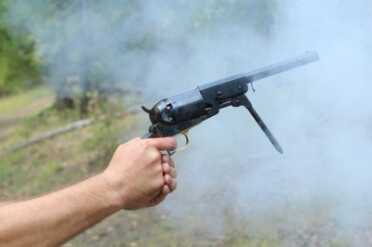
Our test gun needed some tweaking. The loading lever fell when the recoil hit, just like on the originals.
Problems with the Originals
As mentioned above the original Walkers were designed to use loads of 60 grains. There were numerous reports of them suffering from ruptured cylinders. Colt then recommended loading with 50 grains. The Dragoon model revolvers that followed the Walker where made with a shorter cylinder for this reason. There are two possible theories why the Walkers had these failures. One is the metallurgy of the time and the steel was just not up to the standards we have today. The other is that the Walker shipped with conical bullets and molds. Some have speculated that the conical bullets where loaded in backwards (they are much easier to load that way) and would jam on the forcing cone on the barrel and create dangerously high pressures in the cylinder. Whatever the cause, the ruptured cylinders forced Colt to change the guns that followed, leaving the Walker as the most powerful of the cap and ball colts (when it didn’t explode).
The other issue is a minor one. The recoil makes the loading lever drop with just about every shot. We experienced this during the review as well. As you can see in the pictures, the design on the Walker is not strong enough to keep the lever up. This was changed on all the revolvers that followed from Colt.
The Uberti
Since the Uberti uses modern metals, we don’t have to worry about blowing up a cylinder, at least not using round balls. I still wouldn’t load a conical bullet in backwards. But it is safe to load 60 grains in the Uberti, and we did. And, for those of you following along at home, 60 grains is a lot in a black powder pistol. While it doesn’t kick like a .44 Magnum, it does kick. Remember, we’re trying to take out horses at 100 yards.
Making Smoke
We took the Uberti Walker to the range a couple of times to put it to use. We tested it with 30 grain pyrodex pellets, the ones designed for revolvers, and with regular FF black powder. I didn’t keep a good count on how many rounds total we fired, but it was close to 100. Everything functioned as it should until we started to get some fouling build up. But this is black powder and equivalents, and that comes with the territory. Around the 40 round mark I had to use a brush to knock some of the build up off the hammer as it was starting to bind when fired. This resulted in a misfire, until I fixed the issue then it was good for the rest of the rounds. The other thing is the action started to bind up a little. The cylinder stop was not dropping free when on half cock. A little wiggle of the cylinder would usually free everything up.
Shooting Groups
This is not a target revolver, to say the least. The fixed nature of the sights and the fact that the rear one is on the hammer, which moves, illustrates this point. The Walker shoots acceptable groups for what it is, in my opinion. From 25 yards they were around 4 inches. A 9 inch barreled revolver should do a better than that. I am sure that with some work I could find a load and bullet combination what would do better (but not much due to the sights). It will shot minute-of-Coke-can from 25 or so yards.
Here at GunsAmerica, we strive for verisimilitude. Yet try-as-we-might, we could find no one who would volunteer to let us shoot a horse out from under them. We did put up the giant piece of cardboard below, to see how well it was connecting at 100 yards. After several cylinders at the 4′ x4′ sheet of cardboard, we hadn’t scored one hit. Needless to say, I wouldn’t pull the trigger on this at 100 yards, unless I thought the Mexican and his horse might be easily scared by smoke and loud noise.
Why no hits at that distance? We’re still not certain. We were on a wide open range, one that extended out to 300 yards, and we couldn’t see the impacts. The bullets were not hitting short, and our target was a good four feet off the ground, so we were simply slinging lead into the void behind it. After 20 rounds or so, we gave up the attempt. It wasn’t worth the effort. Whatever hold-off, or hold over, or combination that it would have required would have made shooting at that distance little more than a novelty.
Numbers
So is the Walker in the ballistic range of what you would expect of a .357 Magnum? Here are the numbers from our tests. These were shot using Hornady .457 144 grain round balls.
60 grains of Pyrodex pellets averaged – 1490 ft/s
60 grains Goex FF Black Powder averaged –1385 Ft/s
[one_half]
[/one_half][one_half_last]
[/one_half_last]
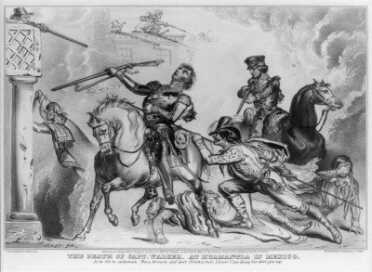
Why is walker dying with a useless rifle in his hands? Where is his Walker? And why isn’t the lancer, or the lone gunman on the balcony riding a horse? They are supposed to be on horses!
According to the tests done at Ballistics By the Inch, a 140 grain Cor Bon .357 out of a 9 inch barrel will travel at 1745 ft/s. So we are less than 300 ft/s slower out of the Walker with the same barrel length. But how many 9 inch barreled .357s are out there? The same .357 load out of a 4 inch barrel is 1394 ft/s. That might be a little bit of apples to oranges but the power is pretty close. If this was an episode of the Myth Busters I wouldn’t call this one BUSTED.
Still. Legend has it that Walker was killed by a Mexican lancer–as in a guy with a sharpened stick. Make of that what you will. My guess is that this group of Mexicans were wise to the Walker’s limitations. They probably danced around at 100 yards and let the soldiers empty their chambers, and then ran in and poked them with sticks. Or maybe they waited for Walker to mail the guns back to Colt, and then surprised them with the sharpened sticks. Either way, there was a lesson here, and Samuel Colt (who maintained a respectable distance from sharpened sticks) figured it out fast enough.
Final Thoughts
This is a really fun black powder revolver. I am a history nerd and it is a blast to shoot these type of guns. The cleaning and slow loading kind of sucks, but that is all part of it. Uberti makes some very nice reproductions and their version of the Walker is yet another example of the quality I have come to expect from them. Shooting a reproduction is not quite the same as an original. But the modern materials more than make up for it. You can bet that if I had a chance to shoot an original I sure wouldn’t load up 60 grains and see if I could push it to .357 levels. Let’s leave the ruptured cylinders to the past.
[one_half]
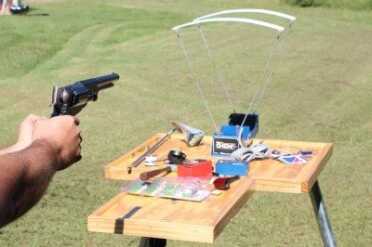
Don’t shoot the chrony. I’d suggest getting back a bit, too, just so the force doesn’t blow things apart.
[/one_half][one_half_last]
[/one_half_last]
[one_half]
[/one_half][one_half_last]
[/one_half_last]
[one_half]
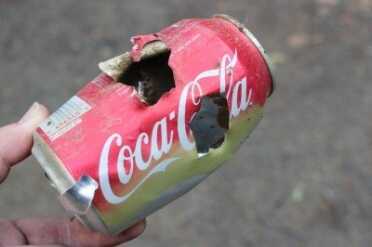
In the end, maybe because I can still legally own modern handguns, I find the Walker to be a great fun gun.
[/one_half][one_half_last]
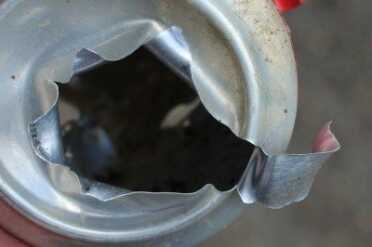
The walker is accurate enough for plinking. After we’d gotten used to point of aim, we tore up some cans.
[/one_half_last]
[one_half]
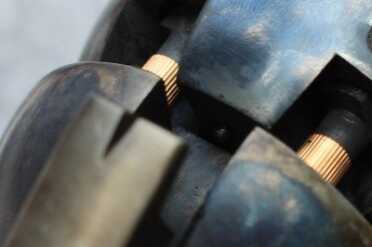
This little nib on the cltnder catches the hammer and lets you carry it with the hammer down and all cylinders loaded.
[/one_half][one_half_last]
[/one_half_last]
[one_half]
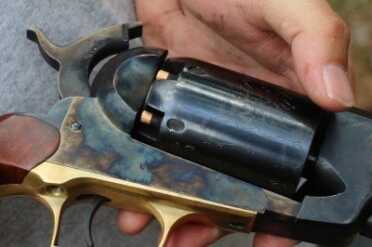
The caps are by far the most difficult part of loading. They are small, tiny when compared to the rest of the gun.
[/one_half][one_half_last]
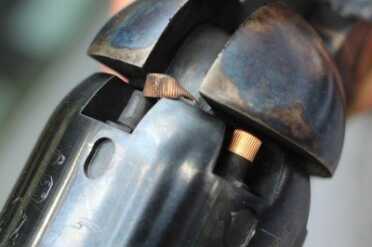
We did have a problem with caps popping off and getting caught in the tight spaces around the hammer.
[/one_half_last]
[one_half]
[/one_half][one_half_last]
[/one_half_last]
[one_half]
[/one_half][one_half_last]
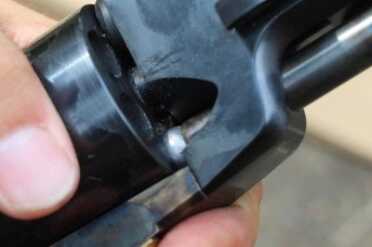
How fast can you seat six balls? It becomes easier with practice, but would still be a pain in the ass while Mexicans are trying to shoot you off your horse.
[/one_half_last]
[one_half]
[/one_half][one_half_last]
[/one_half_last]
[one_half]
[/one_half][one_half_last]
[/one_half_last]
[one_half]
[/one_half][one_half_last]
[/one_half_last]
[one_half]
[/one_half][one_half_last]
[/one_half_last]
[one_half]
[/one_half][one_half_last]
[/one_half_last]

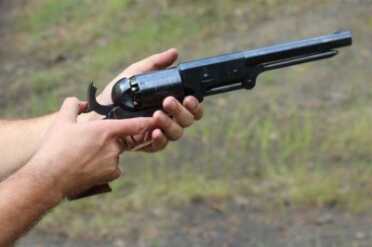
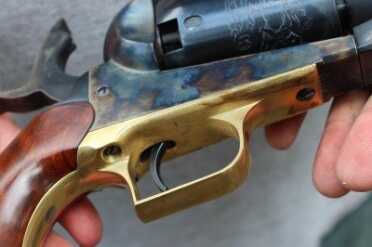
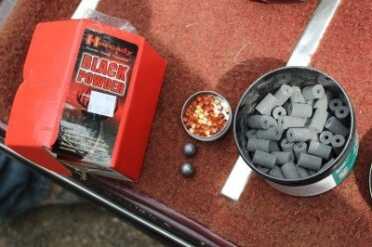
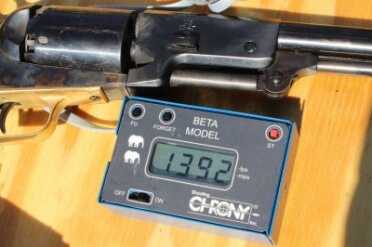
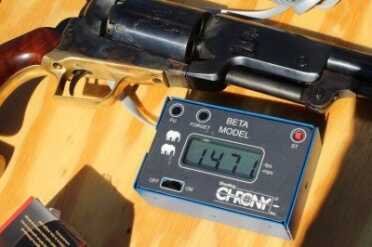
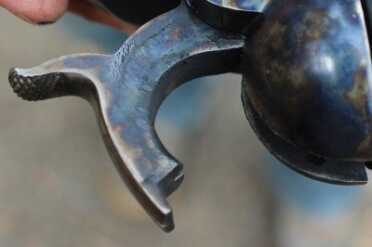
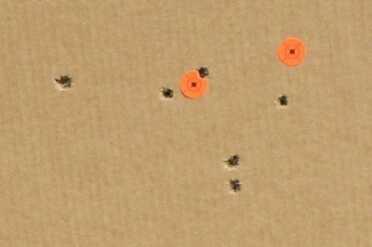
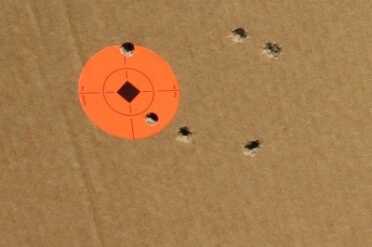
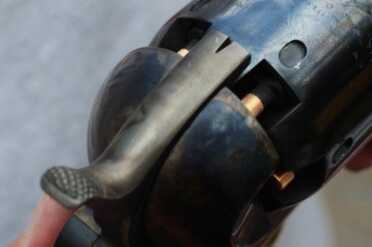
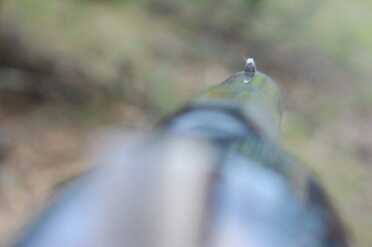
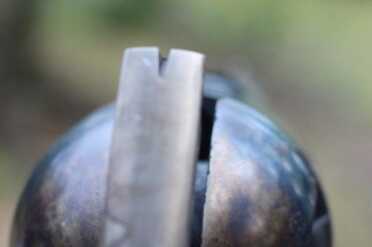
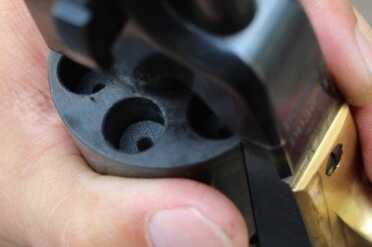
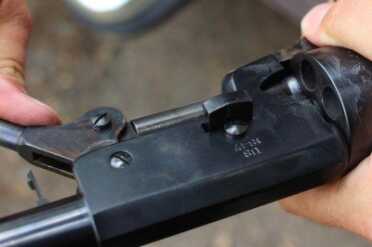
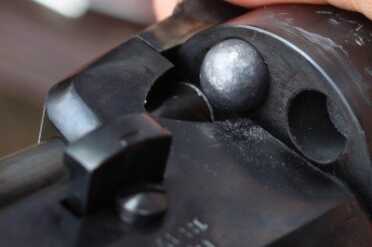
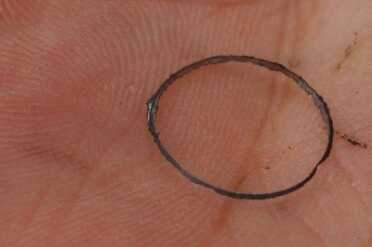
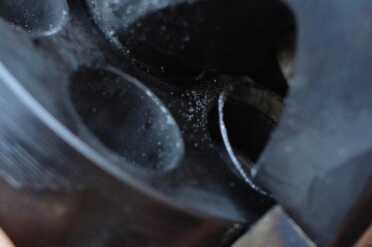
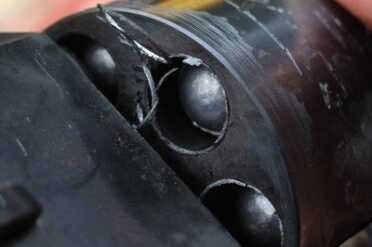
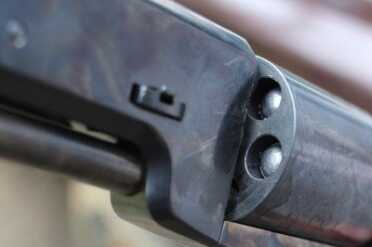
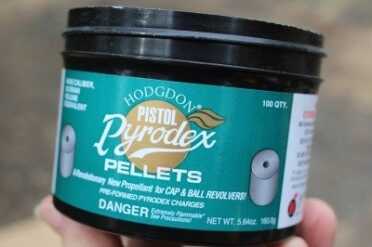
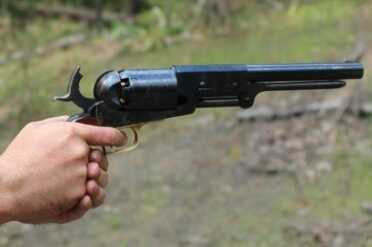
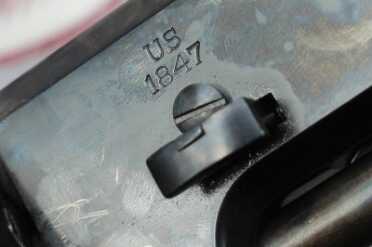
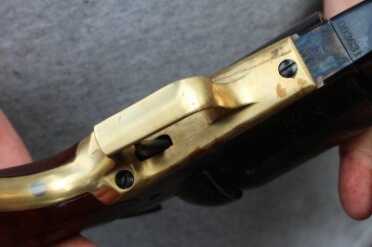
Have shot BP for over 50 years rifles, shot guns db and single, revolvers. I hunt with my BP guns. Navy Arms DB 12ga with 75g FFF shot cup filled with #4 shot over shot wad works great on grouse and rabbit. Single 12ga made in Spain no other markings 60g FFF paper wad and 1oz riffled slug great on deer. CVA Kentucky. 45 with 60g FFF patch and round ball deer, bear, ground hog to keep in practice in summer and change the site a little. CVA 50cal 90g FFF with 355gr TC Maxie Hunter Deer, Black Bear, Hog. Side arm Uberta Walker 50g FFF with 1/8 dry felt wad and a .450 Lee conical with TC bore butter in grooves and sealed over top Also makes clean up easier. or a Remington 1858 Uberta with 35gr FFF 1/8 dry felt wad and .454 Lee round ball covered with TC bore butter. These have put meat on table and never failed me, I have all kind of cartridge guns but hunting with these just makes me feel like I am hunting. And by the way not over bait piles that just takes the sport out of it. Get out learn your game and know what it is going to do and when it is going to be moving it just tastes better to me. Always use soft lead for black powder. Just though some of the younger black powder shooter might be able to use this. Not saying this is correct just worked for me. And by the way It is BLACK POWDER yes harder to clean and harder to get but it is worth it.
I have owned and shot many black powder rifle and pistol over the years, and have found if you load them properly they are as deadly as anything on the market today. I concurrently own a Rugar in 45cal it is very accurate to 50 yards, I would put it up against anything modern! I sent it to the Rugar factory and had a extra cylinder made. It makes it easier to change loads when shooting. Watch the movie Josie Wales ,it’s were I got my inspiration for the extra cylinder. Good shooting!
5 shots is why everyone who could, carried 2 or 3 pistols.
YOU MUST REMOVE THAT PICTURE WITH “TWO HANDED” CAPTION! I CAN’T BELIEVE ANYONE WHO’S EVER SHOT A REVOLVER WOULD DEMONSTRATE HOLDING ONE THAT WAY. VERY IRRESPONSIBLE JOURNALISM. VERY FOOLISH GUN HANDLING. I’m NOT sorry for yelling. That gap between the barrel and cylinder…yeah, really REALLY hot gasses and molten lead spray out of there…Mythbusters demonstrated that one with a chicken leg to simulate human hand. If I were the range officer and saw you do this. I would bar you for life. https://www.google.com/webhp?sourceid=chrome-instant&ion=1&espv=2&ie=UTF-8#q=mythbusters%20revolver%20cylinder%20gap
I have a Remington 1858 but I’ve decided I’m going to grab a couple of engraved Walkers somewhere down the line.
It sits in the hand really well, haven’t had the chance to shoot it yet.
While I don’t own and have never fired a Colt-Walker, I do own a 1851 Navy Colt in .36 caliber.
While fooling around with powder loadings, I managed to over load it and caused the charging arm to fall, as it mentioned above, with the Walker. My solution was to cut back on the amount of powder. End of problem.
Unfortunately, I moved a few years ago and I couldn’t locate my pistol from then, up until last month, when I finally found it and it’s accessories, behind the read seat of my F350, where I must have stuffed it. It is now rusted into immobility. Perhaps I can try some rust buster and save it, but it’s looks will never be quite the same.
It was a real pain to clean, until I learned about soap and water. Solvent just doesn’t do the trick, unless you sheep dip the thing. lol.
I had hoped to convert it to accept .38 Spl., in the manner in which they were originally converted to take metal cartridges, but was told that it would be cost prohibitive. :~(
I have more that a passing familiarity with the Walker. Six of my relatives, from the Dallas area, served in Company K of the First Volunteer Texas Rangers in that war. All were issued Walkers at Vera Cruz and the pistol served them well during the conflict. Old family letters reported killing the Mexicans at distance. Perhaps these Texas country men were better marksmen. Extra cylinders were carried and the loading lever tied up with a leather thong.
Good article!
If you have an interest in history, BP guns and/or target shooting check out N-SSA.ORG; there may be a team near you.
I have over 30 Black powder rifles and handguns I always use a wonder lube patch over the ball to reduce fouling and to stop chain fires using 60 grain of triple f I could kill the horse at 100 yards all day long don’t know what you did but try try again.
What a fun article, making it tempting to put a black powder gun back on the shopping list. No surprise you couldn’t hit anything at 100 yards – firing a ball that is no longer spherical due to the shaving will yield very unpredictable results at distance. This calls for another test with conical and mini-ball bullets!
I have had a pair of these Uberti’s (consecutive Serial #’s) and they are a “blast” to shoot.This article is very well written and is true to what I have experienced. Cheap shooting, massive smoke ball and realitivly accurate. If you want a fun gun then this is one that should be considered.
Great firearm! More fun is the Second Model Dragoon made by Colt in the 1970s. .457 ball over 40gr of Pyrodex makes a healthy charge. They do shoot high at 30 feet, but group very well.
the manual from Uberti says for this gun you use a standard charge of black powder of 22 grs and a maximum of 30 grains for a the size lead ball some how you put 60 grs max Why?
Liability concerns, I presume: the manufacturers don’t want to be sued for any Kabooms. Pietta recommended 12 grains for an 1861 .36 cal. Navy that I have. The ball did not make it past the forcing cone. 15 grains were no more successful. I shoot 20 grains with good success. The max volume on the Colt .36 is 25 grains, the max on the .44 1860 Army is 35 grains. More powder generally results in the guns shooting high and with les accuracy, but individual guns vary. And any fears are probably overstated, as black powder produces far less pressure than smokeless. Combined with modern metallurgy (stronger steel) (and the fact that there are cylinder conversions available for cartridge rounds), the risk of a cylinder rupture is slim.
It has been found that a lot of chain fires came from loose caps and flash over to a nipple not shielded sufficiently by the cylinder cutout. I had a well used brass 1851 .36 that I used for sound effects for theatre, no powder, just caps and my assistant used wrong size caps. The audience must have thought that the soldier firing his Springfield 1861 had a machine gun.
You didn’t mention lubrication. Traditionally it’s grease smeared on top of the bullets to keep the fouling soft, but recently I read that by the second shot the recoil has it jump from the chambers, which is why many will put lubed-filled felt wads between the powder and the ball, also preventing chain fires. This may have improved the groups.
I have both the Uberti New Army Revolver and the Walker, GREAT FUN both of them. The New Army is amazingly accurate all the way out to 100 Yds, believe it or not a 10ins group! It certainly make me look good even though I don’t deserve it. The Walker, less so, but maybe as per the comments above it may be better at the longer ranges. No real ‘kick’, just a heck of a push, loads of smoke and a real crowd puller at the range. Re power, I don’t have a chrony but they both turn 44 lead balls into tinfoil at 100 yds. Draw back on the Walker vs the New Army, the cylinder change option on the smaller pistol makes for a much faster reload, its why the Walkers were originally ordered / supplied in pairs with a pommel rig. I carry mine during hunting season with my mind on old gut piles and bears. P.S. I use the Remington ‘magnum’ caps, they are much more reliable than ‘standard’ caps. They are both more fun than a fella should be allowed to have with his clothes on! Mike
Most states including Texas the black powder only season is actually called muzzle loader season. You can carry it, but unless it loads though the muzzle (which this does not) you better not shoot a deer with it during muzzle loader season. If the game wardens catch you, you’ll lose it and pay a hefty fine on top.
It would be nice to see black powder shooting become popular again as it was in the 1970’s. I used to shoot black powder often back then but then moved on to modern shooting, but I am now re-discovering how much fun it is to shoot percussion pistols. Unfortunately getting real black powder isn’t as easy as it was, and it costs more as well to have it shipped Haz-mat as many gun stores don’t or won’t stock it. Still, bringing these types of guns to the range always attracts onlookers to see the shooting process and to see why there’s so much smoke! My “modern” Dragoon is a Ruger Old Army, and loaded up it is an impressive display as to how powerful these “antique” firearms can be.
I would agree with texasqtrhorse that it would be more powerful than the .357 mag. since it fires a heavier bullet. I have a Second Model Colts Dragoon by Uberti. It fires a .45 caliber ball at 850 fps with 40 grs. of Pyrodex P. Interestingly, that load is equivalent to the old .45 Colt blackpowder load, which in turn is similar to the .45 ACP. What I find interesting is that the ballistics of what would put a man down remained unchanged from the 1850’s through 1985 when the military went with the 9mm. Fun to shoot but I wouldn’t want to be in a gun fight and have the cylinder bind up from a loose cap-as can happen easily.
I always use some type of grease over the ball to prevent chain fire. As far as shooting them goes they are a point shoot gun, I could hit every time by point shooting but aiming with sights is iffy. Shooting from the hip if you point it at the belt buckle it will hit the hart every time. I always use FFFg and this gives me a six inch high point of impact.About 75 yards maybe the reproduction lowered the sight picture for modern times.
There are capping and decapping tools. They are inexpensive. If you had used intermediate range targets you might have seen where the shots were going and used Kentucky windage to hit the 100 yd. target. What do you say?
Please you guys, It is NOT 45 LONG Colt, Just 45 Colt. I know why it is referred to this way but the true name is just 45 Colt.
They made a short military colt round, which by default makes these a long colt round even though the official name was never long colt, the short colt made these a long colt round.
They are right about the loading lever falling down on every shot. The Texas Rangers would tie a small strip of leather around the barrel and loading lever to hold it up, when they went to reload they could slip it toward the end of the barrel and release the lever without completely removing it, then slip it back on when it was loaded. Also they are saying it was as powerful as a .357, but they just gave the speed of the bullet and not the weight in grains of either bullet they were firing. As everybody knows the heavier the bullet the more powerful it is. The heavier bullet in this gun would make it more powerful than a .357.
True but there isn’t room to shoot two 30 grain pellets and a heavier LONGER bullet.
Some tips not mentioned by the author: I use .45 lead 185 grain semi wad cutters with 60 grains of powder and the accuracy soars, plus the lube in the groove drops fouling tremendously. The proper way to shoot a cap-and-ball was to cock the pistol for the next shot with the barrel pointed skyward. This drops any loose caps harmlessly onto your horse to singe his hair, not yours. A rubber band holds the lever from flopping just fine and they are not too expensive, last time I checked.
Great article! Thanks. I have two of the Uberti repros in 44 black powder and the other in 45LC (converted with a drop in cylinder). They are a hoot to shoot. I’m going to have to look at this on for my collection.
I looked up my 7.5″ redhawk and it comes out to 54 ounces which is just under 3.4 pounds. That’s a BIG handgun. The only thing I’ve seen bigger was one fellow’s 45-70 revolver I saw and HEARD fired several times. Very impressive if you like that sort of thing. I know that I would not be happy with a black powder firearm due to all the crude involved but the Colt Walker is pretty impressive. That said, I think I’ll stick to my 2X22=Redhawk.
Have one (since 1994) I found using peroxide P , wonder wads and .454 balls makes for a lot better accuracy. Also hold pistol nozzle up while cocking after shot this allows busted cap to fall free to prevent jam. Enjoy all my black powder guns.
Have one (since 1994) I found using peroxide P , wonder wads and .454 balls makes for a lot better accuracy. Also hold pistol nozzle up while cocking after shot this allows busted cap to fall free to prevent jam. Enjoy all my black powder guns.
I bought one for $125 about 10 years ago. The store was having an inventory clearance. After shooting it with much delight, I finally purchased a cylinder that accepted .45 Colt cowboy loads. It used an individual firing pin in each chamber and sped-up the loading process at the range. Today my Uberti Colt Walker replica rests in a velvet-lined presentation case, along with bullet mold, powder flask, etc. in a drawer. I’ll bring it out for visitors to admire, and they get a history lesson each time. Terrific article! Thanks.
I took mine out to the woods during deer season and I brought down a buck who was along side a doe. It was about 35-40 yds out and it went thru the bucks shoulder and out the side into the doe taking out her lungs. It made some nasty holes with 60 grains!
any thought to using FFF black powder? in my experience FFF is used for pistols and small caliber rifles.
FF is for use in the large bore ‘brown bess’ muskets like the brits used and also for the smaller cannons
I have an older one of these hand cannons, same manifacture, from around the mid 70’s, still works great… (As you mentioned FFF by rule of thumb is for .44 and smaller cals. , FF is for larger.) the Walker is at the line.
Anyways, I fire FFF in mine, no problems……. and as far as power, it is very impressive. I use either the round ball or the 200 grain conical from the mould that came with the pistol in the 70’s, as the auther mentied. I have fired this 200 grain bullit at a 8 to 10″ pine tree at about 15 to 20 feet, loaded the correct way with 60 grains of FFF black powder, it all but went through the tree, nosed out the other side. I then turned the bullet around noise first when loading (backwards so to speak) with 60 grains of FFF black powder, fired it at the same poor tree, impact in the front of the tree was impressive as it took of the bark in a 2 to 3 inches in radius to where the bullet entered the tree, just shear impact power of a wad cutter I guess, that round did not come out the other side. In fact I have fired a 250 grain minie ball in this pistol, a little less FFF power, as 6o grains would not fit. Probably not something you would want to do all the time, but a real black bear stopper .
Great pistol………………………………………………………………………….
If you have ever shot a black powder weapon you are hooked, I asked Santa
‘for one for Christmas Hope she heard.
Great, my very own 6-shot Portable 12-Pounders.
A very entertaining read. Good job.
This was an excellent, informative, and seemingly objective review. I had been considering the purchase of one of these reproductions, but just was not sure. After reading this review, I am going to go ahead and buy one. I actually believe this is an inexpensive home defense weapon. The reload time is a protracted, and lengthy process. However, having been an N.R.A. Police Firearms instructor for 25 Plus years, I am confident that in a home invasion situation, you most likely will not need more than six rounds.
The one thing I am curious about that was not covered in the review, is the actual amount of measurable kinetic energy transference into the body cavity by use of ballistic jel.
I suspect that it would rival, and more than likely exceed the “stopping power” of the .45 ACP, which is substantial.
So, in conclusion, thanks for a great review. Very well done, great information, and all the math was done.
Best Reards,
Sgt. Doug “Harpo” Harper
Would be fun to fire the Walker , a bummer to load . If all else fails ,you can buffalo someone with it .
I have one of these. and I do enjoy shooting it. it shoots high up close but get a target out about 100 yards and it is about dead on. I have killed one buck with mine. baring in mind that it shoots high up close.
I think if shtf, this may come in handy to hunt with. The biggest issue would be supplies of all the materials. You would be limited to what you had on hand. If the government ever came for your “registered” weapons, this would be an ace in the hole. Also, if you ever fired this, you would be alerting every living thing in a 15 mile radius probably. No surprise visits after the shot.
This is an awesome article. I have a couple repro’s of these pistols I have been sitting on for several years. I just may have to break em out and go see what they can do.